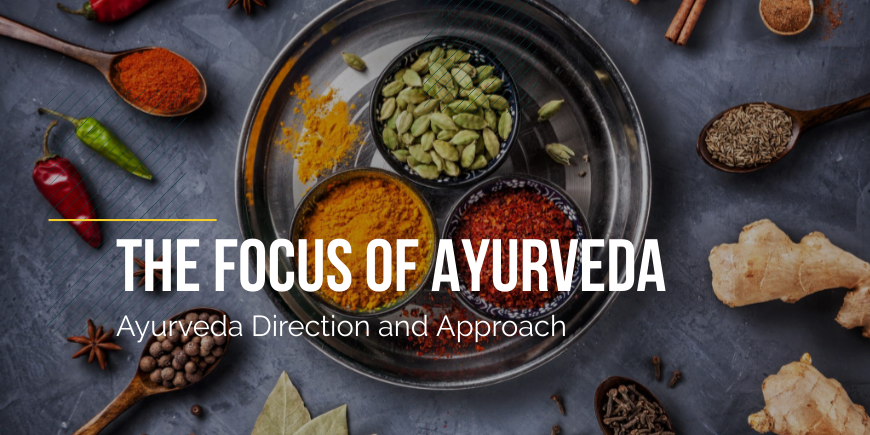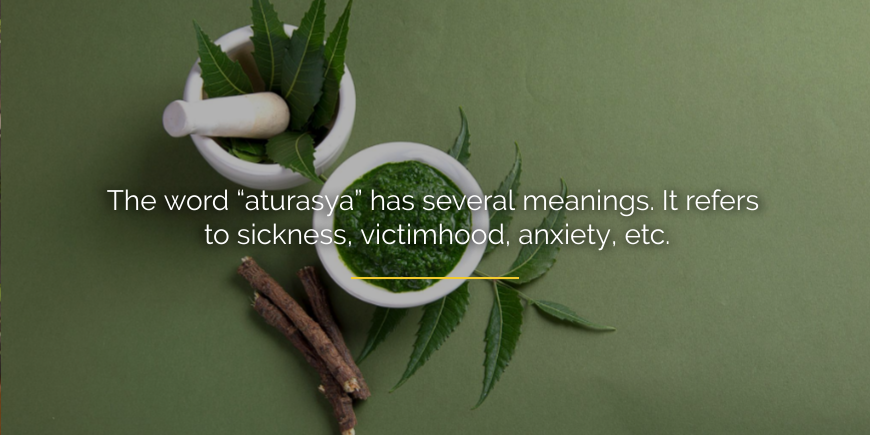
Introduction
Focus is the defining factor for any science. It defines the direction and the approach. The focus also defines the success or failure of the approach. According to the law of attraction, you get want you to focus on. Therefore, Ayurveda has a most comprehensive and eternally relevant healthcare focus. It focuses on health and not on diseases. Ayurveda does not focus even on prevention, because a focus on prevention is also disease-focus in principle.
Focus on Health
A beautiful shloka (verse) in CharakSamhita defines the focus of Ayurveda as follows-
Swasthasyaswasthasyarakshanam
Aturasyavikarprashamana Cha
Charak Samhita
(First,) preserve the health of the healthy,
(Then) alleviate disorders in the diseased one.
The sequence of text is very important in all shloka. Something that is mentioned earlier is supposed to provide a context for everything that proceeds. Here health comes before treatment, which provides a completely new perspective on healthcare.
Let us elaborate on the first sentence – (First,) preserve the health of the healthy,
Normally, the primary focus of medical science is to cure the sick. Let us assume that we have a tree of disease inside our bodies. In that case, a focus on diseases prevention or treatment is akin to a focus on the collection of leaves constantly falling from a tree. Treatment is akin to collecting leaves after they fall, whereas prevention is akin to a collection of leaves before they fall. But the only difference is the time lag. The focus stays the same – a focus on diseases.
But Ayurveda has a different approach – a flawless approach towards healthcare. It focuses not on the disease, not even on disease prevention. And here is how it works –
Let us revisit the example of the tree of disease. When we focus on the tree, we incidental diverting our attention and efforts from health preservation. Instead of thinking about a permanent solution, we focus on finding more effective ways to collect the leaves.
Ayurveda says – make the body healthy. When we make the body healthy, we incidentally make it infertile for the tree of disease. The tree of disease can no longer survive inside the body. It dies off instantly and effortlessly. There is no need to collect leaves. There is no need to prevent or cure!
For example, if you are worried about a COVID-19 infection, you may focus more on washing hands, than eating healthy. Because we have a limited attention span and limited resources, one focus competes with the other. But the point is that – if you have weak immunity, you may catch the virus through the air! So, the real prevention is inside not outside. And the focus changes the gun-point. We shoot at the wrong target and lose the bullets.
Because of a focus on diseases, most people end up taking medications the whole of their lives. If only they know how to focus on health, they will incidentally eliminate the disease-causing factors and become healthy. Health is the natural state of the body. Only if we stop tempering with the normal biorhythm, the body automatically regain health. That is why, Ayurveda says – love the body and there will be no disease left to hate!
And focus on health is an aggressive healthcare aim compared to focusing on disease. Once, we turn our focus on preserving health, we become conscious of our physical, mental, and spiritual needs. We become attentive to our hunger, thirst, and natural urges. We can discriminate between real hunger and impulses for stress-eating. We can make wiser dietary and lifestyle decisions. And, then we do not have to fight diseases, because our body is infertile for all pathogenic factors. There can be no disease! There is no need for prevention too!
The above statement from Charak Samhita is a precept for the physicians. Physicians are the brains of society. They lead society with their focus. The emphasis of a physician should be to preserve the health of the healthy. This statement is very important as it is a very forceful attitude towards health. Let us imagine that if the health of all people is well preserved, there is no need for prevention and probably, there will be no sick people to cure in the first place.
Summary
Power flows where the attention goes! According to the law of attraction, we invite what we focus on. That is why Ayurveda focuses on health and not only on prevention or cure of diseases.
Psychosomatic Approach
Now, let us shift our focus to the second line of the verse –(Then) eliminate the disorders of the anxious.
The word “aturasya” has several meanings. It refers to sickness, victimhood, anxiety, etc.
There are many words for sick in Sanskrit – rogi (suffering from disease), vikrit (deformed/imbalanced), vyadhit (inflicted by disorder), and many more. But Master Charak choose the word “atur”.I like the word “atur” because it signifies the mental state of the person. One of its meanings is “anxious”.
This is a deep statement with multiple implications.
One of the implications is – the importance of the state of mind.
Ayurveda defines three states of mind in a sick person. The word satva stands for the mind/mettle of a person.

Pravarsatva
A person with pravarsatva may be suffering from a grave disorder with lots of pain or discomfort, but he will stay cool and composed. Such people have great control over their minds. This is the reason they are ideal candidates for placebo treatment. They can use their mind to divert their physiology!
MadhyamSatva
A person with madhyamsatva will have moderate composure. If she is very sick, she will show a reasonable level of stress and anxiety. These people are in line with their feelings, and physical symptoms. They may respond to treatment depending on their faith in it.
Heen/Avarsatva
A person with heen (low) satva will exhibit exponential symptoms, or anxiety compared to her disorder. Paranoid people (who fear falling sick) come under this category. These people may have a hard time getting treated. Sometimes, they keep changing the line of treatment or experimenting with new physicians to ensure “better” treatment.
Treat The Mind
Looking at the larger picture, Master Charak defines where health preservation ends and disease treatment begins. The people with pravarsatva can still focus on health preservation. Vedas believe that the mind is the origin of the mind. It is like the software that controls a robot. So, if we can change/correct the software, we can change the way the robot works.
Besides, today there are ample examples where people cured themselves of fatal disorders just with the placebo effect of faith and hope.
The people with madhyamsatva also can benefit from the health focus and the self-healing power of mind and body. However, they do well with a combination of health preservation and treatment.
The people with heensatva are anxious. They can fall into a vicious cycle of depression and worsening symptoms. They are the “atur” or the anxious, which could also be understood in the above verse. They need more medical attention. So, a physician must focus on their mind with techniques like assurance, positive attitude, belief, and calmness long-term treatment for these people.
Another aspect of “atur” treatment is that – if you do not treat these people, they spread negativity and disease phobia in society. They become “gods of diseases,” spreading fear and doubts. Therefore, it is imperative to treat these people, or better still, make them feel treated urgently.
Summary
The mind is the source of both health and disease. Therefore, Ayurveda focuses on the psychological aspect of the treatment more than the physiological one. Because, if you can cure the disease-anxiety, the mind will allow the body can heal itself.
Take Away
Ayurveda talks about a positive and aggressive healthcare aim of preserving health, rather than only focusing on diseases. As we strengthen the body, it becomes infertile for the disorders. This approach eliminates the question of prevention or treatment!
Unlock the secrets of holistic healing with our Ayurveda Certification Course! Immerse yourself in the ancient wisdom of Ayurveda and embark on a transformative journey towards optimal health and well-being. Learn from renowned experts and experienced practitioners as they guide you through the principles of Ayurveda.
Whether you’re a healthcare professional or simply passionate about natural healing, this course will empower you to make a profound difference in people’s lives. Enroll now and, bringing harmony and vitality to yourself and others.